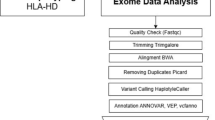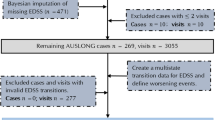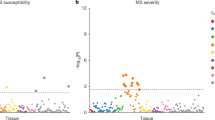Abstract
A recent genome-wide association study (GWAS) performed by the The Wellcome Trust Case–Control Consortium based on 12 374 nonsynonymous single-nucleotide polymorphisms (SNPs) provided evidence for several genes involved in multiple sclerosis (MS) susceptibility. In this study, we aimed at verifying the association of 19 SNPs with MS, with P-values ≤0.005, in an independent cohort of 732 patients and 974 controls, all Caucasian from the South of Spain. We observed an association of the rs17368528 polymorphism with MS (P=0.04, odds ratio (OR)=0.801, 95% confidence interval (CI)=0.648–0.990). The association of this polymorphism with MS was further validated in an independent set of 1318 patients from the Canadian Collaborative Project (P=0.04, OR=0.838, 95% CI=0.716–0.964). This marker is located on chromosome 1p36.22, which is 1 Mb away from the MS-associated kinesin motor protein KIF1B, although linkage disequilibrium was not observed between these two markers. The rs17368528 SNP results in an amino-acid substitution (proline to leucine) in the fifth exon of the hexose-6-phosphate dehydrogenase (H6PD) gene, in which some variants have been reported to attenuate or abolish H6PD activity, in individuals with cortisone reductase deficiency. This study corroborates the association of one locus determined by GWAS and points to H6PD as a new candidate gene for MS.
Similar content being viewed by others
Log in or create a free account to read this content
Gain free access to this article, as well as selected content from this journal and more on nature.com
or
References
Hauser SL, Oksenberg JR : The neurobiology of multiple sclerosis: genes, inflammation, and neurodegeneration. Neuron 2006; 52: 61–76.
McElroy JP, Oksenberg JR : Multiple sclerosis genetics. Curr Top Microbiol Immunol 2008; 318: 45–72.
Ramagopalan SV, Knight JC, Ebers GC : Multiple sclerosis and the major histocompatibility complex. Curr Opin Neurol 2009; 22: 219–225.
Matesanz F, Caro-Maldonado A, Fedetz M et al: IL2RA/CD25 polymorphisms contribute to multiple sclerosis susceptibility. J Neurol 2007; 254: 682–684.
International Multiple Sclerosis Genetics Consortium: Risk alleles for multiple sclerosis identified by a genomewide study. N Engl J Med 2007; 357: 851–862.
Gregory SG, Schmidt S, Seth P et al: Interleukin 7 receptor alpha chain (IL7R) shows allelic and functional association with multiple sclerosis. Nat Genet 2007; 39: 1083–1091.
Lundmark F, Duvefelt K, Iacobaeus E et al: Variation in interleukin 7 receptor alpha chain (IL7R) influences risk of multiple sclerosis. Nat Genet 2007; 39: 1108–1113.
Aulchenko YS, Hoppenbrouwers IA, Ramagopalan SV et al: Genetic variation in the KIF1B locus influences susceptibility to multiple sclerosis. Nat Genet 2008; 40: 1402–1403.
Kristjansdottir G, Sandling JK, Bonetti A et al: Interferon regulatory factor 5 (IRF5) gene variants are associated with multiple sclerosis in three distinct populations. J Med Genet 2008; 45: 362–369.
Hoppenbrouwers IA, Aulchenko YS, Ebers GC et al: EVI5 is a risk gene for multiple sclerosis. Genes Immun 2008; 9: 334–337.
Hafler JP, Maier LM, Cooper JD et al: CD226 Gly307Ser association with multiple autoimmune diseases. Genes Immun 2009; 10: 5–10.
International Multiple Sclerosis Genetics Consortium (IMSGC): The expanding genetic overlap between multiple sclerosis and type I diabetes. Genes Immun 2009; 10: 11–14.
Wellcome Trust Case Control Consortium: Association scan of 14 500 nonsynonymous SNPs in four diseases identifies autoimmunity variants. Nat Genet 2007; 39: 1329–1337.
Ban M, Goris A, Lorentzen AR et al: Replication analysis identifies TYK2 as a multiple sclerosis susceptibility factor. Eur J Hum Genet 2009; 17: 1309–1313.
Poser CM, Paty DW, Scheinberg L et al: New diagnostic criteria for multiple sclerosis: guidelines for research protocols. Ann Neurol 1983; 13: 227–231.
Sadovnick AD, Risch NJ, Ebers GC : Canadian collaborative project on genetic susceptibility to MS, phase 2: rationale and method. Canadian Collaborative Study Group. Can J Neurol Sci 1998; 25: 216–221.
Lyons DA, Naylor SG, Scholze A, Talbot WS : Kif1b is essential for mRNA localization in oligodendrocytes and development of myelinated axons. Nat Genet 2009; 41: 854–858.
Kletzien RF, Harris PKV, Foellmi LA : Glucose-6-phosphate dehydrogenase: a housekeeping enzyme subject to tissue-specific regulation by hormones, nutrients, and oxidant stress. FASEB J 1994; 8: 174–181.
Vaughn AE, Deshmukh M : Glucose metabolism inhibits apoptosis in neurons and cancer cells by redox inactivation of cytochrome C. Nat Cell Biol 2008; 10: 1477–1483.
Draper N, Walker EA, Bujalska IJ et al: Mutations in the genes encoding 11beta-hydroxysteroid dehydrogenase type 1 and hexose-6-phosphate dehydrogenase interact to cause cortisone reductase deficiency. Nat Genet 2003; 34: 434–439.
Acknowledgements
We thank the patients with multiple sclerosis and persons who acted as controls for making this study possible. Financial support for the study was provided by the Ministerio de Ciencia e Innovación and Fondos Europeos de Desarrollo Regional (FEDER) (grants PN-SAF2006-02023 and PN-SAF2009-11491) and Junta de Andalucía (P07-CVI-02551) to A Alcina, and Fondo de Investigación Sanitaria (FIS, grant number PI081636) and Servicio Andaluz de Salud (PI0168-2007) to F Matesanz. The Multiple Sclerosis Society of the United Kingdom and the Multiple Sclerosis Society of Canada Scientific Research Foundation support the Canadian Collaborative Study Group. SNP genotyping services were provided by the Spanish ‘Centro Nacional de Genotipado CEGEN-USC, www.cegen.org. María Fedetz is a holder of a fellowship from Fundación IMABIS. Dorothy Ndagire is a holder of Agencia Española Cooperación Internacional (AECI)-Ministerio de Asuntos Exteriores fellowship.
Author information
Authors and Affiliations
Corresponding author
Ethics declarations
Competing interests
The authors declare no conflict of interest.
Rights and permissions
About this article
Cite this article
Alcina, A., Ramagopalan, S., Fernández, Ó. et al. Hexose-6-phosphate dehydrogenase: a new risk gene for multiple sclerosis. Eur J Hum Genet 18, 618–620 (2010). https://doi.org/10.1038/ejhg.2009.213
Received:
Revised:
Accepted:
Published:
Issue date:
DOI: https://doi.org/10.1038/ejhg.2009.213
Keywords
This article is cited by
-
The conundrum of iron in multiple sclerosis – time for an individualised approach
Metabolic Brain Disease (2012)
-
Multiple sclerosis pharmacogenetics: personalized approach towards tailored therapeutics
EPMA Journal (2010)



